NURS3012 - End-of-Life Care: An Annotated Bibliography & Critique
VerifiedAdded on 2023/06/03
|5
|1149
|481
Annotated Bibliography
AI Summary
This annotated bibliography focuses on end-of-life care, analyzing research articles related to decision-making burdens on families and nurses' experiences in long-term care hospitals. The annotations summarize the studies' methodologies, findings, strengths, and limitations, highlighting implications for nursing practice. Key themes include the emotional burden on families making end-of-life decisions for cancer patients and the challenges faced by nurses in balancing quality of life with life-sustaining treatments. The bibliography emphasizes the importance of empathetic communication, patient-centered care, and collaborative discussions between healthcare providers, patients, and families to improve end-of-life care experiences. It also includes a brief critique of an article comparing routine vs. clinically indicated replacement of intravenous catheters.
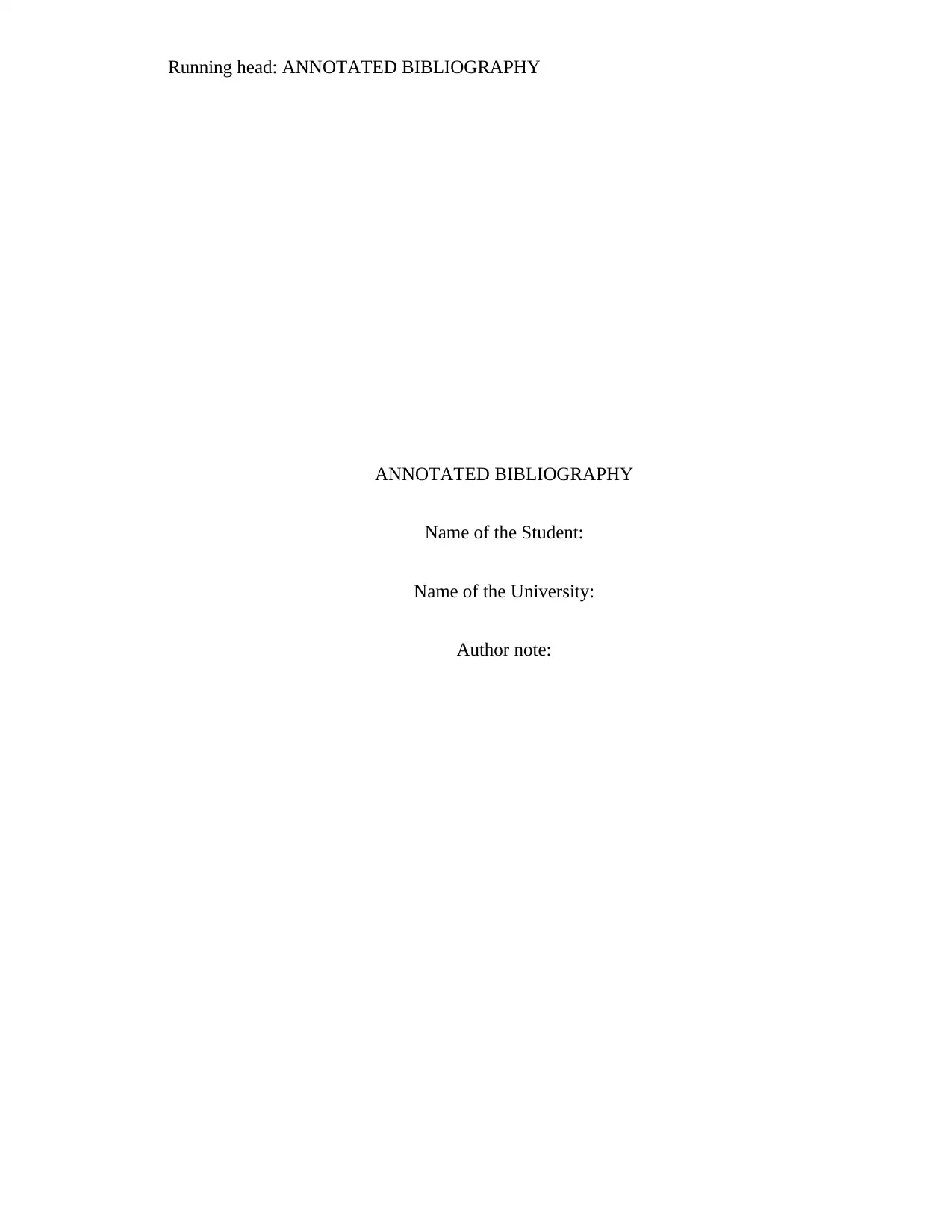
Running head: ANNOTATED BIBLIOGRAPHY
ANNOTATED BIBLIOGRAPHY
Name of the Student:
Name of the University:
Author note:
ANNOTATED BIBLIOGRAPHY
Name of the Student:
Name of the University:
Author note:
Paraphrase This Document
Need a fresh take? Get an instant paraphrase of this document with our AI Paraphraser
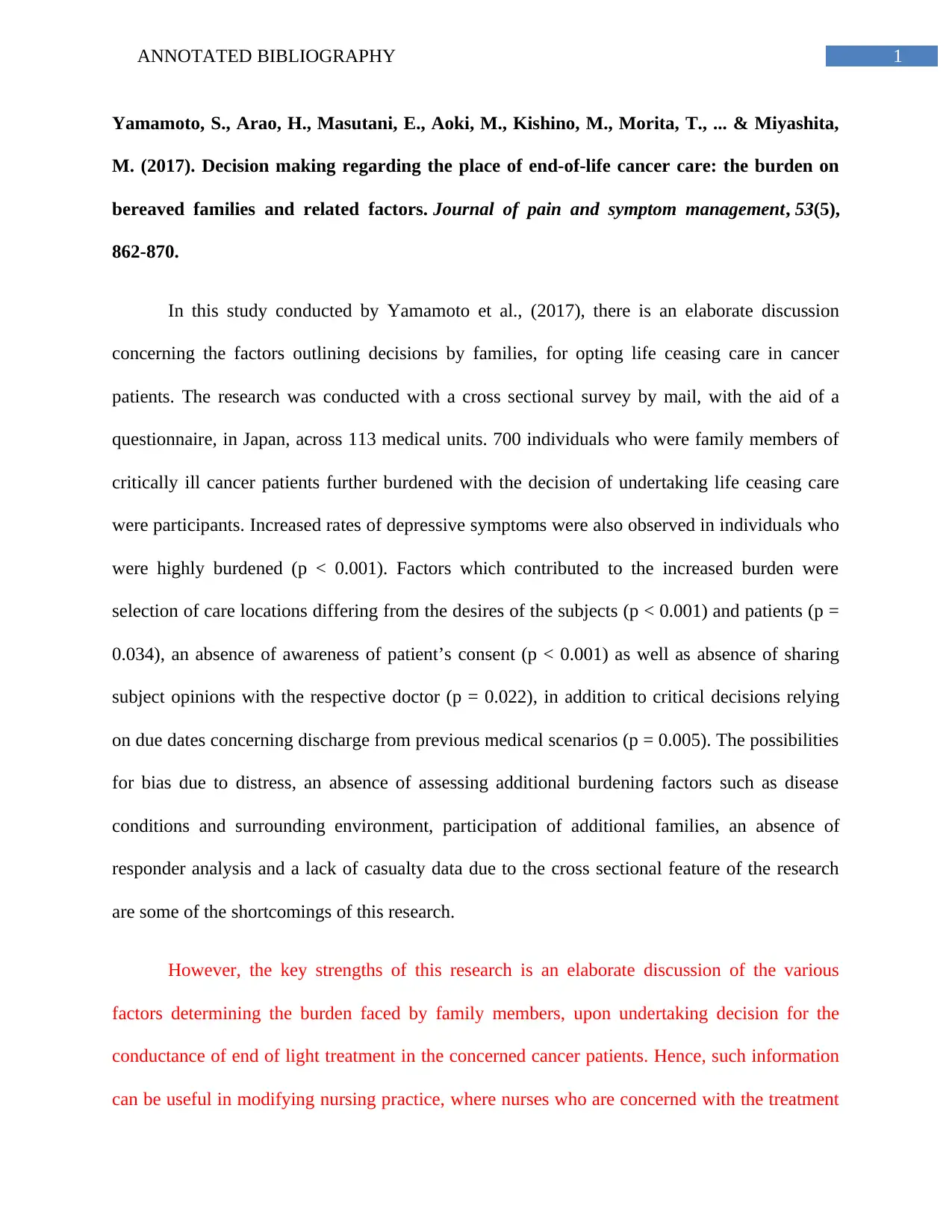
1ANNOTATED BIBLIOGRAPHY
Yamamoto, S., Arao, H., Masutani, E., Aoki, M., Kishino, M., Morita, T., ... & Miyashita,
M. (2017). Decision making regarding the place of end-of-life cancer care: the burden on
bereaved families and related factors. Journal of pain and symptom management, 53(5),
862-870.
In this study conducted by Yamamoto et al., (2017), there is an elaborate discussion
concerning the factors outlining decisions by families, for opting life ceasing care in cancer
patients. The research was conducted with a cross sectional survey by mail, with the aid of a
questionnaire, in Japan, across 113 medical units. 700 individuals who were family members of
critically ill cancer patients further burdened with the decision of undertaking life ceasing care
were participants. Increased rates of depressive symptoms were also observed in individuals who
were highly burdened (p < 0.001). Factors which contributed to the increased burden were
selection of care locations differing from the desires of the subjects (p < 0.001) and patients (p =
0.034), an absence of awareness of patient’s consent (p < 0.001) as well as absence of sharing
subject opinions with the respective doctor (p = 0.022), in addition to critical decisions relying
on due dates concerning discharge from previous medical scenarios (p = 0.005). The possibilities
for bias due to distress, an absence of assessing additional burdening factors such as disease
conditions and surrounding environment, participation of additional families, an absence of
responder analysis and a lack of casualty data due to the cross sectional feature of the research
are some of the shortcomings of this research.
However, the key strengths of this research is an elaborate discussion of the various
factors determining the burden faced by family members, upon undertaking decision for the
conductance of end of light treatment in the concerned cancer patients. Hence, such information
can be useful in modifying nursing practice, where nurses who are concerned with the treatment
Yamamoto, S., Arao, H., Masutani, E., Aoki, M., Kishino, M., Morita, T., ... & Miyashita,
M. (2017). Decision making regarding the place of end-of-life cancer care: the burden on
bereaved families and related factors. Journal of pain and symptom management, 53(5),
862-870.
In this study conducted by Yamamoto et al., (2017), there is an elaborate discussion
concerning the factors outlining decisions by families, for opting life ceasing care in cancer
patients. The research was conducted with a cross sectional survey by mail, with the aid of a
questionnaire, in Japan, across 113 medical units. 700 individuals who were family members of
critically ill cancer patients further burdened with the decision of undertaking life ceasing care
were participants. Increased rates of depressive symptoms were also observed in individuals who
were highly burdened (p < 0.001). Factors which contributed to the increased burden were
selection of care locations differing from the desires of the subjects (p < 0.001) and patients (p =
0.034), an absence of awareness of patient’s consent (p < 0.001) as well as absence of sharing
subject opinions with the respective doctor (p = 0.022), in addition to critical decisions relying
on due dates concerning discharge from previous medical scenarios (p = 0.005). The possibilities
for bias due to distress, an absence of assessing additional burdening factors such as disease
conditions and surrounding environment, participation of additional families, an absence of
responder analysis and a lack of casualty data due to the cross sectional feature of the research
are some of the shortcomings of this research.
However, the key strengths of this research is an elaborate discussion of the various
factors determining the burden faced by family members, upon undertaking decision for the
conductance of end of light treatment in the concerned cancer patients. Hence, such information
can be useful in modifying nursing practice, where nurses who are concerned with the treatment
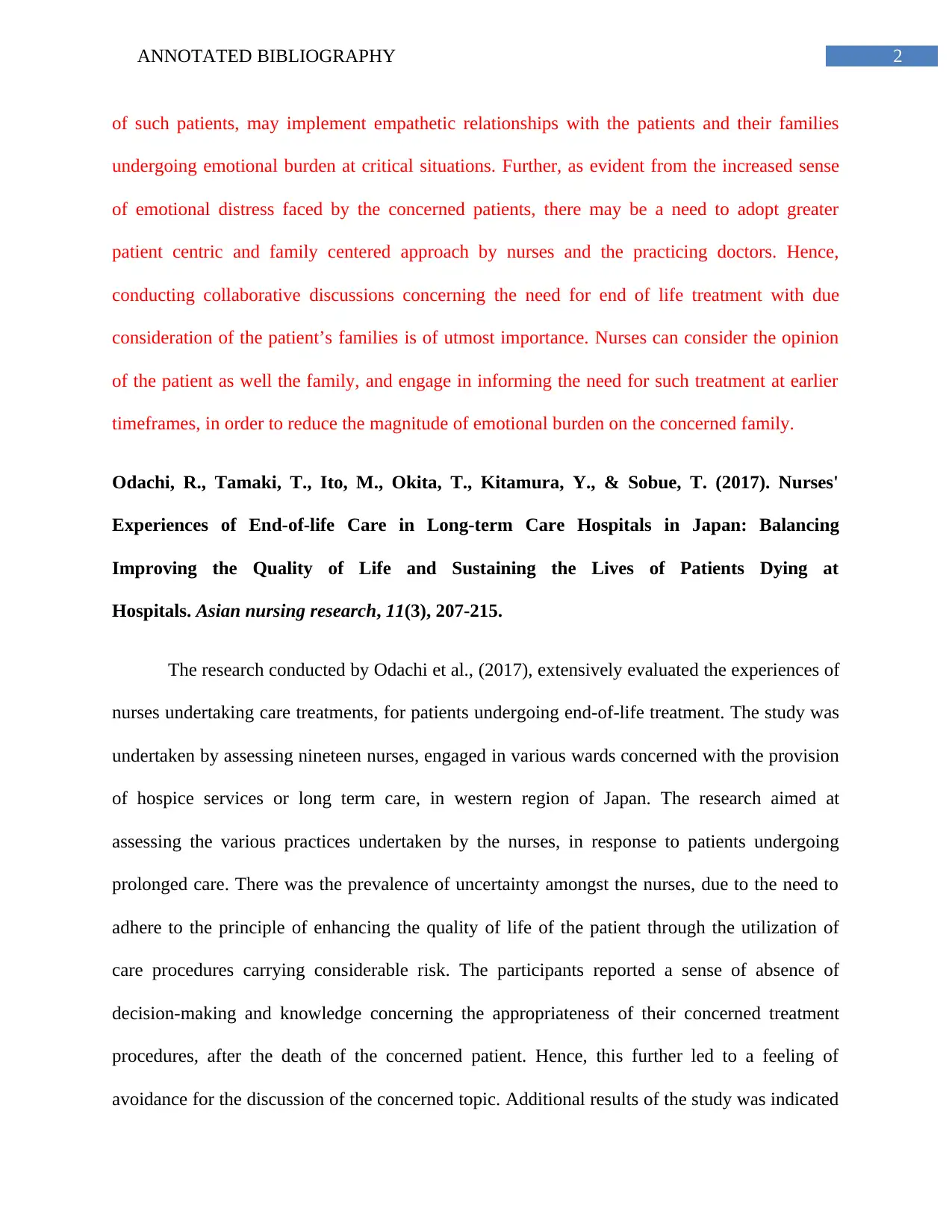
2ANNOTATED BIBLIOGRAPHY
of such patients, may implement empathetic relationships with the patients and their families
undergoing emotional burden at critical situations. Further, as evident from the increased sense
of emotional distress faced by the concerned patients, there may be a need to adopt greater
patient centric and family centered approach by nurses and the practicing doctors. Hence,
conducting collaborative discussions concerning the need for end of life treatment with due
consideration of the patient’s families is of utmost importance. Nurses can consider the opinion
of the patient as well the family, and engage in informing the need for such treatment at earlier
timeframes, in order to reduce the magnitude of emotional burden on the concerned family.
Odachi, R., Tamaki, T., Ito, M., Okita, T., Kitamura, Y., & Sobue, T. (2017). Nurses'
Experiences of End-of-life Care in Long-term Care Hospitals in Japan: Balancing
Improving the Quality of Life and Sustaining the Lives of Patients Dying at
Hospitals. Asian nursing research, 11(3), 207-215.
The research conducted by Odachi et al., (2017), extensively evaluated the experiences of
nurses undertaking care treatments, for patients undergoing end-of-life treatment. The study was
undertaken by assessing nineteen nurses, engaged in various wards concerned with the provision
of hospice services or long term care, in western region of Japan. The research aimed at
assessing the various practices undertaken by the nurses, in response to patients undergoing
prolonged care. There was the prevalence of uncertainty amongst the nurses, due to the need to
adhere to the principle of enhancing the quality of life of the patient through the utilization of
care procedures carrying considerable risk. The participants reported a sense of absence of
decision-making and knowledge concerning the appropriateness of their concerned treatment
procedures, after the death of the concerned patient. Hence, this further led to a feeling of
avoidance for the discussion of the concerned topic. Additional results of the study was indicated
of such patients, may implement empathetic relationships with the patients and their families
undergoing emotional burden at critical situations. Further, as evident from the increased sense
of emotional distress faced by the concerned patients, there may be a need to adopt greater
patient centric and family centered approach by nurses and the practicing doctors. Hence,
conducting collaborative discussions concerning the need for end of life treatment with due
consideration of the patient’s families is of utmost importance. Nurses can consider the opinion
of the patient as well the family, and engage in informing the need for such treatment at earlier
timeframes, in order to reduce the magnitude of emotional burden on the concerned family.
Odachi, R., Tamaki, T., Ito, M., Okita, T., Kitamura, Y., & Sobue, T. (2017). Nurses'
Experiences of End-of-life Care in Long-term Care Hospitals in Japan: Balancing
Improving the Quality of Life and Sustaining the Lives of Patients Dying at
Hospitals. Asian nursing research, 11(3), 207-215.
The research conducted by Odachi et al., (2017), extensively evaluated the experiences of
nurses undertaking care treatments, for patients undergoing end-of-life treatment. The study was
undertaken by assessing nineteen nurses, engaged in various wards concerned with the provision
of hospice services or long term care, in western region of Japan. The research aimed at
assessing the various practices undertaken by the nurses, in response to patients undergoing
prolonged care. There was the prevalence of uncertainty amongst the nurses, due to the need to
adhere to the principle of enhancing the quality of life of the patient through the utilization of
care procedures carrying considerable risk. The participants reported a sense of absence of
decision-making and knowledge concerning the appropriateness of their concerned treatment
procedures, after the death of the concerned patient. Hence, this further led to a feeling of
avoidance for the discussion of the concerned topic. Additional results of the study was indicated
⊘ This is a preview!⊘
Do you want full access?
Subscribe today to unlock all pages.

Trusted by 1+ million students worldwide
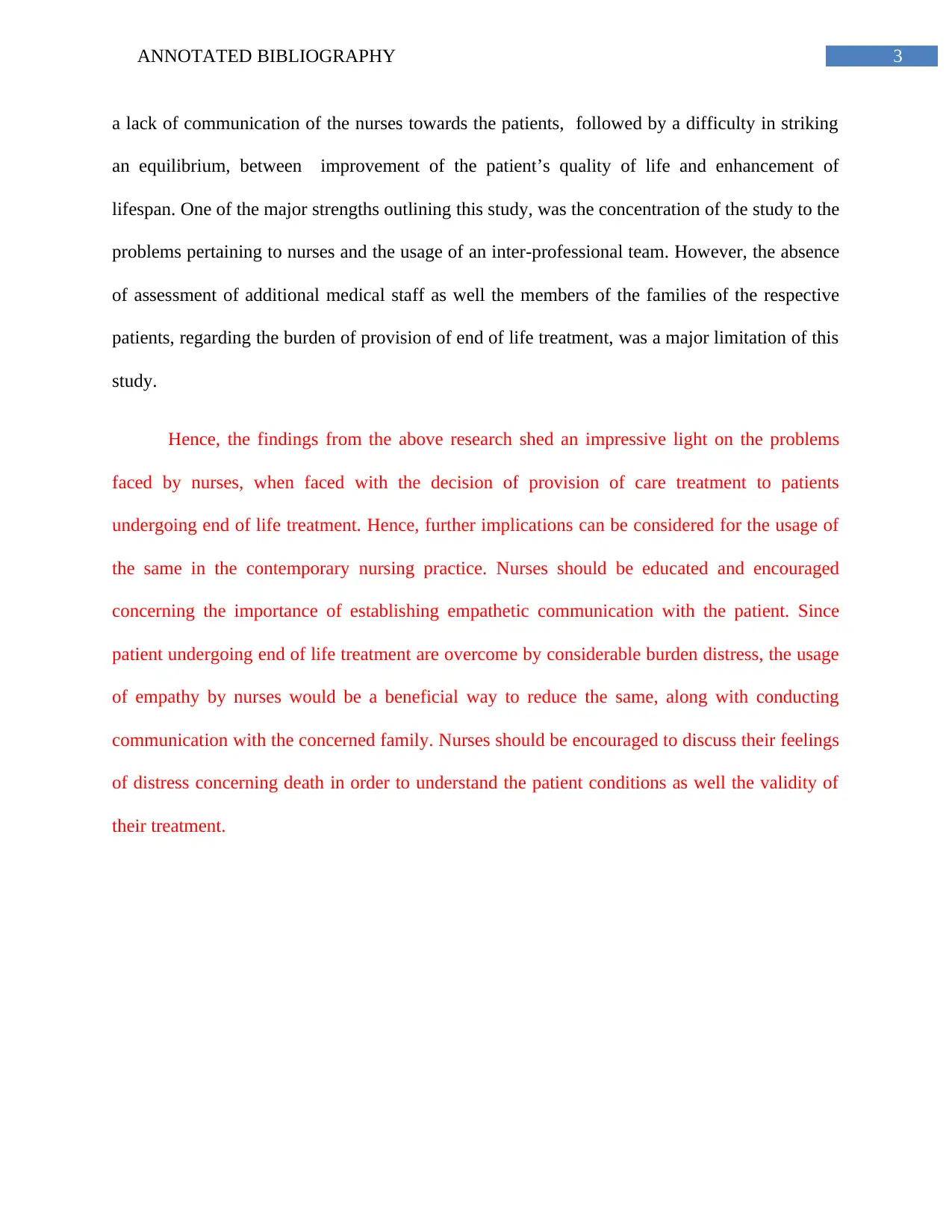
3ANNOTATED BIBLIOGRAPHY
a lack of communication of the nurses towards the patients, followed by a difficulty in striking
an equilibrium, between improvement of the patient’s quality of life and enhancement of
lifespan. One of the major strengths outlining this study, was the concentration of the study to the
problems pertaining to nurses and the usage of an inter-professional team. However, the absence
of assessment of additional medical staff as well the members of the families of the respective
patients, regarding the burden of provision of end of life treatment, was a major limitation of this
study.
Hence, the findings from the above research shed an impressive light on the problems
faced by nurses, when faced with the decision of provision of care treatment to patients
undergoing end of life treatment. Hence, further implications can be considered for the usage of
the same in the contemporary nursing practice. Nurses should be educated and encouraged
concerning the importance of establishing empathetic communication with the patient. Since
patient undergoing end of life treatment are overcome by considerable burden distress, the usage
of empathy by nurses would be a beneficial way to reduce the same, along with conducting
communication with the concerned family. Nurses should be encouraged to discuss their feelings
of distress concerning death in order to understand the patient conditions as well the validity of
their treatment.
a lack of communication of the nurses towards the patients, followed by a difficulty in striking
an equilibrium, between improvement of the patient’s quality of life and enhancement of
lifespan. One of the major strengths outlining this study, was the concentration of the study to the
problems pertaining to nurses and the usage of an inter-professional team. However, the absence
of assessment of additional medical staff as well the members of the families of the respective
patients, regarding the burden of provision of end of life treatment, was a major limitation of this
study.
Hence, the findings from the above research shed an impressive light on the problems
faced by nurses, when faced with the decision of provision of care treatment to patients
undergoing end of life treatment. Hence, further implications can be considered for the usage of
the same in the contemporary nursing practice. Nurses should be educated and encouraged
concerning the importance of establishing empathetic communication with the patient. Since
patient undergoing end of life treatment are overcome by considerable burden distress, the usage
of empathy by nurses would be a beneficial way to reduce the same, along with conducting
communication with the concerned family. Nurses should be encouraged to discuss their feelings
of distress concerning death in order to understand the patient conditions as well the validity of
their treatment.
Paraphrase This Document
Need a fresh take? Get an instant paraphrase of this document with our AI Paraphraser
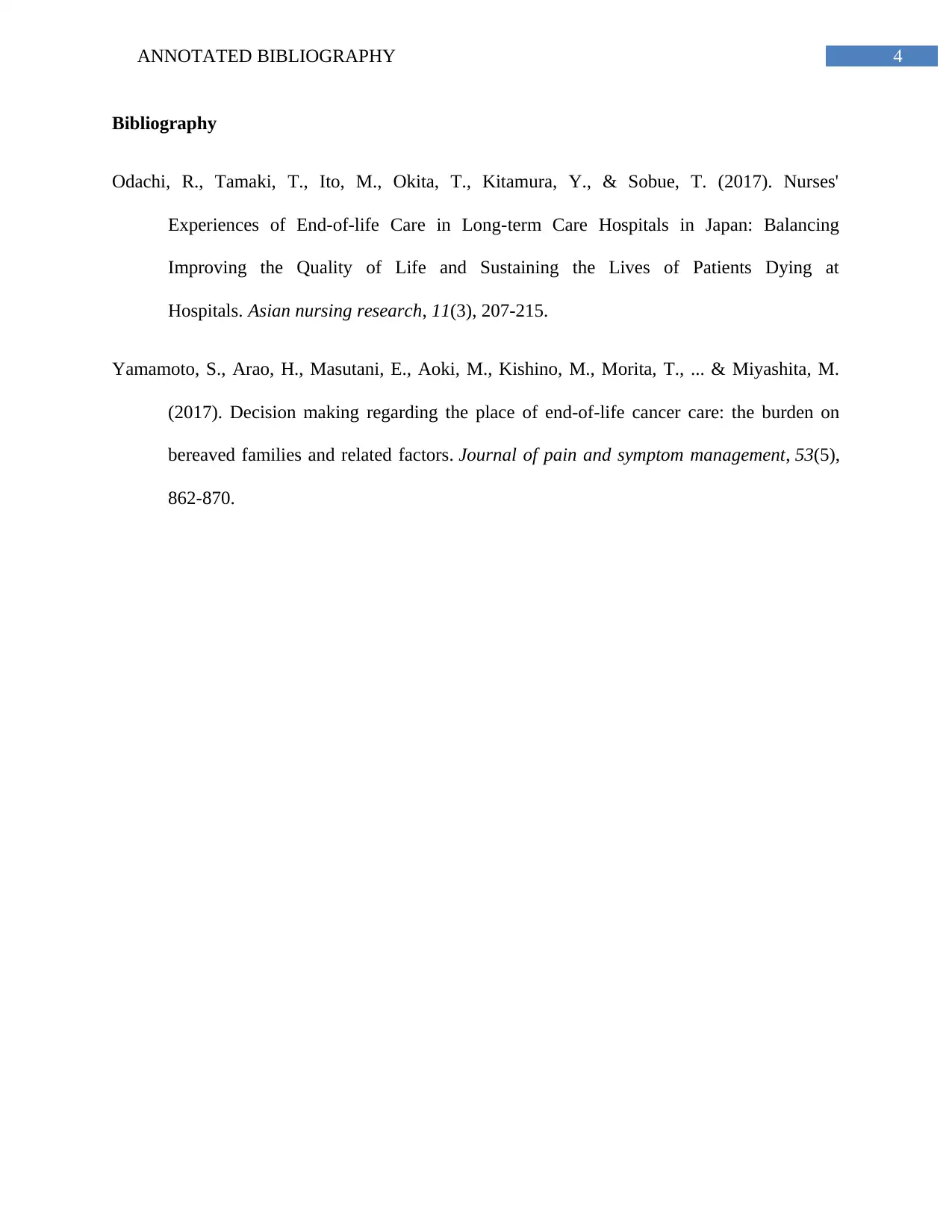
4ANNOTATED BIBLIOGRAPHY
Bibliography
Odachi, R., Tamaki, T., Ito, M., Okita, T., Kitamura, Y., & Sobue, T. (2017). Nurses'
Experiences of End-of-life Care in Long-term Care Hospitals in Japan: Balancing
Improving the Quality of Life and Sustaining the Lives of Patients Dying at
Hospitals. Asian nursing research, 11(3), 207-215.
Yamamoto, S., Arao, H., Masutani, E., Aoki, M., Kishino, M., Morita, T., ... & Miyashita, M.
(2017). Decision making regarding the place of end-of-life cancer care: the burden on
bereaved families and related factors. Journal of pain and symptom management, 53(5),
862-870.
Bibliography
Odachi, R., Tamaki, T., Ito, M., Okita, T., Kitamura, Y., & Sobue, T. (2017). Nurses'
Experiences of End-of-life Care in Long-term Care Hospitals in Japan: Balancing
Improving the Quality of Life and Sustaining the Lives of Patients Dying at
Hospitals. Asian nursing research, 11(3), 207-215.
Yamamoto, S., Arao, H., Masutani, E., Aoki, M., Kishino, M., Morita, T., ... & Miyashita, M.
(2017). Decision making regarding the place of end-of-life cancer care: the burden on
bereaved families and related factors. Journal of pain and symptom management, 53(5),
862-870.
1 out of 5
Related Documents
Your All-in-One AI-Powered Toolkit for Academic Success.
+13062052269
info@desklib.com
Available 24*7 on WhatsApp / Email
![[object Object]](/_next/static/media/star-bottom.7253800d.svg)
Unlock your academic potential
Copyright © 2020–2025 A2Z Services. All Rights Reserved. Developed and managed by ZUCOL.





